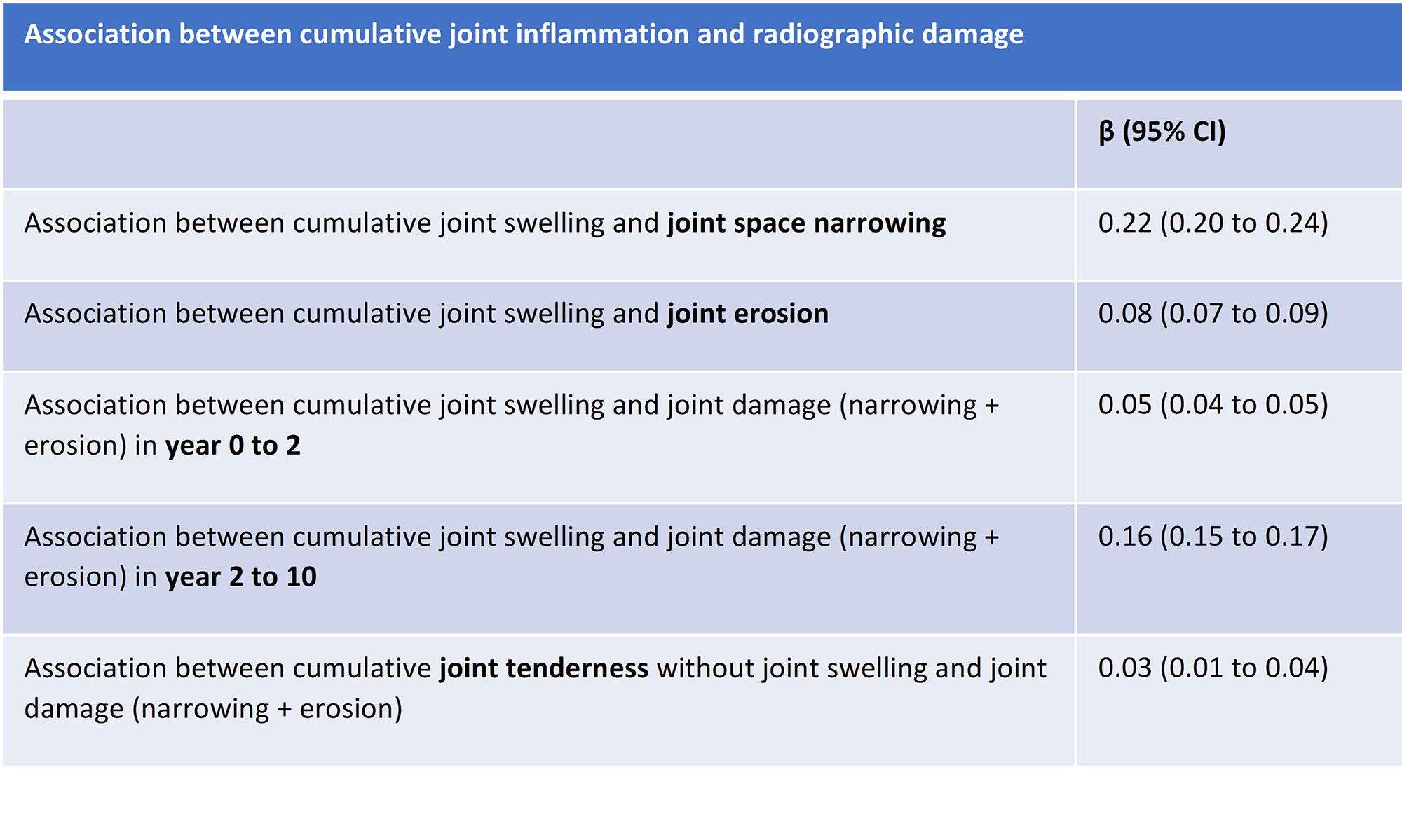Session Information
Session Type: Poster Session D
Session Time: 1:00PM-3:00PM
Background/Purpose: In Rheumatoid Arthritis (RA), both systemic and local disease activity have been shown to be associated with joint damage progression. Earlier we showed that rheumatoid arthritis tends to persist or recur locally. This may affect the patterns of joint damage progression. We aim to investigate whether in treated-to-target RA, cumulative local clinical joint inflammation over time is associated with long-term local radiographic joint damage progression in that same joint.
Methods: Data from the BeSt study were used. Patients were treated to target (DAS ≤2.4) for 10 years. Hands and feet were assessed clinically (three-monthly) and radiographically (yearly). Joint space narrowing and erosions were assessed with the Sharp-Van der Heijde score (SHS). Joint space narrowing scores range from 0 to 4 (normal to bony ankylosis or complete luxation) and erosions from 0 to 5 in hand joints (no erosions to complete bone collapse) and 0 to 10 in feet joints (0-5 per bone in one joint). A generalized linear mixed model was used to assess the association between the percentage of study visits at which inflammation was observed in a joint (2 definitions: joint swelling, and joint tenderness without joint swelling) and the degree of radiographic damage in that joint (percentage of the maximal SHS). Joints were nested within patients. The analyses were repeated for erosions and joint space narrowing separately and for two different time periods (baseline to year 2 and year 2 to 10). Analyses were adjusted for baseline (or year 2) damage and follow-up duration. A permutation test was done to verify that the results reflect a local rather than a general disease activity effect.
Results: Of the 16,082 joints of 473 patients with at least one year follow-up (median (IQR) follow-up time was 41 (25-41) study visits, that is 10 (6-10) years, only 16% (2,547) had radiographic joint damage (SHS ≥ 0.5) at the end of follow-up. At the end of follow-up, damaged joints had a mean (SD) SHS of 2.6 (3.5). . The percentage of visits at which a joint was swollen was associated with the degree of radiographic joint damage progression in the same joint (β = 0.14, 95% CI 0.13 to 0.15): the total damage score is 0.14% higher for each percent increase in the number of study visits at which the joint was swollen. This corresponds to a 0.13 unit increase in total SHS of a joint for each additional visit at which the joint was swollen. Joint space narrowing was more strongly associated with cumulative joint inflammation than joint erosions (β = 0.22, 95% CI 0.20 to 0.24 vs. β = 0.08, 95% CI 0.07 to 0.09). The association between inflammation and local damage was stronger on long (year 2-10) than on short term (year 0-2) and was stronger for joint swelling than for joint tenderness without swelling (Table 1). The permutation test was statistically significant (p< 0.001), indicating a local rather than a systemic effect.
Conclusion: Local clinical joint inflammation has a cumulative effect on the extent of local joint damage progression in RA on short and long term. Our results suggest that this is a local effect that is not sufficiently inhibited by targeted treatment, even though systemic inflammation is suppressed.
To cite this abstract in AMA style:
Heckert S, Bergstra S, Goekoop-Ruiterman Y, Guler-Yuksel M, Lems W, Matthijssen X, Van Oosterhout M, Huizinga T, Allaart C. Cumulative Joint Inflammation Is Associated with Local Joint Damage Progression in Rheumatoid Arthritis Despite Long-Term Targeted Treatment [abstract]. Arthritis Rheumatol. 2022; 74 (suppl 9). https://acrabstracts.org/abstract/cumulative-joint-inflammation-is-associated-with-local-joint-damage-progression-in-rheumatoid-arthritis-despite-long-term-targeted-treatment/. Accessed .« Back to ACR Convergence 2022
ACR Meeting Abstracts - https://acrabstracts.org/abstract/cumulative-joint-inflammation-is-associated-with-local-joint-damage-progression-in-rheumatoid-arthritis-despite-long-term-targeted-treatment/

